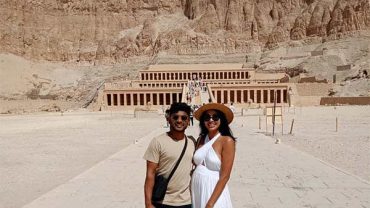Nestled on the west bank of the Nile River in Luxor, Egypt, the Ramesseum Temple stands as a testament to the grandeur of ancient Egyptian architecture and the enduring legacy of Pharaoh Ramesses II. This majestic temple, dedicated to the powerful ruler, offers a captivating journey through time, inviting visitors to marvel at the skill and vision of the artisans who crafted it over three millennia ago.
Historical Significance
The Ramesseum Temple, also known as the “Memorial Temple of Ramesses II,” was constructed during the 13th century BCE. It served as a mortuary temple, commemorating the life and reign of Pharaoh Ramesses II, one of Egypt’s most celebrated leaders. This colossal structure, surrounded by colossal statues and intricately adorned walls, reflects the Pharaonic commitment to monumental architecture as a means of immortalizing their reigns.
Ramesses II, often referred to as Ramesses the Great, ruled for an astonishing 66 years. The temple not only honors his achievements but also serves as a reminder of the significant political and military successes during his era. From battles against the Hittites to the construction of vast architectural wonders, Ramesses II’s reign left an indelible mark on the history of ancient Egypt.
Architectural Marvels
The Ramesseum Temple’s architecture is nothing short of awe-inspiring. The main entrance, adorned with colossal statues of Ramesses II seated on his throne, sets the tone for the grandeur within. The temple complex comprises a series of courtyards, halls, and sanctuaries, each intricately decorated with hieroglyphics and intricate reliefs that narrate the pharaoh’s triumphs and religious beliefs.
One of the most iconic features is the fallen colossus, a massive statue of Ramesses II that now lies on the ground, a poignant reminder of the passage of time. Despite its prone position, the statue exudes a sense of enduring strength and resilience. Exploring the temple, visitors are transported to an era when craftsmanship and devotion converged to create architectural wonders that have withstood the ravages of time.
Spiritual Significance
Beyond its historical and architectural importance, the Ramesseum Temple held profound spiritual significance for the ancient Egyptians. The temple was dedicated to the god Ra, the powerful deity associated with the sun. The alignment of certain architectural elements with celestial bodies and the intricate religious inscriptions emphasize the temple’s role as a sacred space where the earthly and divine realms intertwined.
Visitors today can still feel the spiritual aura as they wander through the temple’s halls, imagining the rituals and ceremonies that once took place within its sacred confines. The Ramesseum Temple not only served as a testament to the pharaoh’s might but also as a conduit for connecting with the divine forces that shaped the ancient Egyptian worldview.
Preservation Efforts and Tourism
In recent years, concerted efforts have been made to preserve and protect the Ramesseum Temple. Restoration projects aim to maintain the structural integrity of the temple and ensure that future generations can continue to marvel at its magnificence. The site’s accessibility to tourists provides a unique opportunity for people from around the world to witness the splendor of ancient Egypt and gain insights into the cultural and religious practices of that era.
Ongoing Discoveries
The allure of the Ramesseum Temple extends beyond its initial excavation and restoration. Ongoing archaeological efforts have unearthed new facets of this ancient marvel, contributing to our understanding of the political, cultural, and religious landscape of ancient Egypt. Recent discoveries within the temple complex have shed light on the intricacies of daily life during Ramesses II’s reign, revealing residential areas and workshops that were integral to the temple’s functioning.
These ongoing excavations not only deepen our historical knowledge but also add layers of nuance to the narrative surrounding the Ramesseum Temple. The discoveries underscore the meticulous planning and execution that went into creating not just a monument to a pharaoh but a thriving center of activity that played a vital role in the community.
Inspiration for Artists and Scholars
The Ramesseum Temple continues to be a wellspring of inspiration for artists, historians, and scholars. Its colossal statues and detailed reliefs have been subjects of fascination for painters, writers, and Egyptologists alike. The intricate hieroglyphics narrating tales of conquests and religious devotion provide a rich source for linguistic and historical studies, offering a window into the mindset of ancient Egyptians.
The temple’s influence extends to the broader artistic and architectural community, with elements of its design echoing in contemporary structures. The enduring appeal of the Ramesseum Temple lies not only in its physical presence but also in its ability to ignite the imagination and creativity of those who encounter its majestic ruins.
Touristic Experience
For the modern traveler, a visit to the Ramesseum Temple is a journey into the heart of ancient Egypt. The site, surrounded by the breathtaking landscapes of Luxor, offers a blend of history, spirituality, and natural beauty. As visitors explore the temple’s chambers and courtyards, they are enveloped in an atmosphere that transports them to a time when gods and pharaohs walked the earth.
Tourists can engage in guided tours that unravel the mysteries of the temple’s construction and the stories carved into its walls. The open-air museum, which houses artifacts recovered from the site, provides a tangible connection to the daily lives of the people who once thrived in the shadow of the grand structure. The Ramesseum Temple, with its evocative presence, has become a cornerstone of Egypt’s cultural heritage tourism.
Preserving the Legacy
Preserving the legacy of the Ramesseum Temple is not just a responsibility for the custodians of the site; it is a collective endeavor that involves the global community. Conservation projects, supported by international organizations and Egypt’s Ministry of Antiquities, aim to ensure that this ancient marvel continues to stand for generations to come. By striking a delicate balance between accessibility and preservation, authorities hope to maintain the site’s integrity while allowing future generations to be captivated by its splendor.




Comment (0)